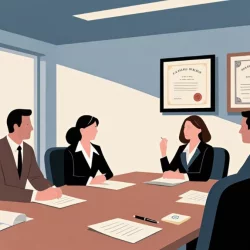How Mediation Can Help Resolve An Employment Law Dispute
When it comes to working as an employee and following the norms and regulations of a corporate environment, many things can go awry from any employee's perspective. Thus, corporate or employment disputes are bound to take place. And as you know, any disagreement or argument is detrimental to the mental and physical health of both the parties involved.
In particular, if we consider the present-day environment where all sorts of activism are taking place, the slightest dispute with an employee can cause a significant loss of major assets to a company. There are high chances of such a loss being endured by the accused corporation or company since it may have to bear the costs of extravagant legal fees and the potential injury - if the victim successfully claims the damages!
As such, a dispute with a key employee can land a well-established company into great trouble. Undergoing the crucial elements and procedures of an employment law dispute can thoroughly devastate a company's image and reputation. Not only this, the mission of handling such a conflict can land even the best of the management teams on their knees! To get out of this impasse, corporates take the assistance of several law firms like Kanter Ostler Mediation & Dispute Resolution that offers mediation for matters of Employment Law dispute. Considering the heinous effects an employment law dispute has for everyone involved, people find it best to have a mediator between them to settle the argument.
What Is Mediation And How Does It Work In Employment Law Disputes?
As the name suggests, mediation is a legal process of passively settling any dispute between two parties in any matter. In mediation, there are generally three parties involved; the two parties involved in the actual conflict and a neutral intermediary – the mediator who aids both the parties arrives at a mutually satisfactory settlement of their argument. One such expert meditation firm is Kanter Ostler Mediation & Dispute Resolution, based in Southern California.
Now, let us move further to see how the process of mediation works in its entirety:
-
Mediation – Distinct From The Process Of Litigation And Trials
Suppose you have been dealing with several legal cases in your corporate life. In that case, you might be familiar with the fact that the process of mediation is different from that of other standard practices such as litigation or trials. On the one hand, litigation deals with filing a lawsuit and presenting persuasive arguments in or against the defense and vice versa. On the other hand, mediation is a unique legal practice that allows both the parties at dispute to willingly enter a meeting in which they, along with the mediator, brainstorm to find the best possible solution to the predicament.
-
Mediation – No Hard And Fast Rules
The only pro and con of this legal procedure is that it bears no hard and fast rules for the disputed parties to come into concordance with a solution. It solely depends on the willingness and flexibility of the disputed parties to find an appropriate solution properly. While mediation allows the parties to face each other peacefully, and through the process of discussion and deliberations, reach a sound and reasonable solution – the chances of this working out fluctuate. Besides, it is well known by almost every mediator and mediation firms like Kanter Ostler Mediation & Dispute Resolution that mediation is only up to 80% effective when the parties are willing to listen to and understand each other.
Now that we have gained some knowledge about mediation and its working in the professional and corporate arena let us enlighten you about the four divergent employment law disputes.
Types Of Common Employment Disputes
Be it an employer or an employee; you should be aware of your rights and duties as a diligent worker and citizen, which you have gained under your State and Federal laws. Moreover, when we talk of employment disputes or anything related to the corporate paradigm, we also draw our specific attention to the regulations established by your employment contract. Speaking of which, there are three types of conventional disputes that can arise in employment law. These are:
-
Wage Disputes
This is perhaps the most prevalent problem that can arise within a corporate framework. We all want to be fairly paid for the time spent and work done on our jobs. Thus, this dispute occurs when an employee accuses their employer of not completely compensating them for the jobs that he/she has done. From a legal perspective, this accusation can include; an employer is not paying his/her employees for the overtime and earned incentives, including the employee not paying even the minimum wage. In such a case, it is advisable to seek mediation help from Kanter Ostler Mediation & Dispute Resolution in Southern California.
-
Wrongful Allegations Of Termination
In hindsight, wrongful termination cases are civil lawsuits under the diaspora of an employment law dispute. However, on the surface, a matter of wrongful termination is often considered the most emotionally-indulging and challenging employment law dispute. In this allegation, the plaintiff (victim) petitions the Court to grant him/her compensations for the loss incurred by them through their employer terminating them for any reason while a contract was in place.
-
Discrimination And Harassment Claims
Well, there are already defined Federal and State laws operating that protect a worker from the following:
Discrimination, unfair treatment by managers or co-workers, harassment in any form, and denial of necessary accommodations in the workplace, along with retaliation by the employer.
These types of disparities that arise in a workplace may compel the worker to take several legal actions, following which the employer and his corporation may be severely affected. That is why this type of employment law dispute requires a meditation between the workers and their employees from Kanter Ostler Mediation & Dispute Resolution.
More to Read:
Previous Posts:










